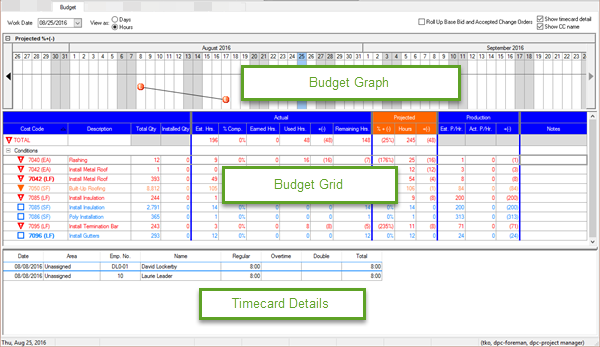Production/Budget tracking is calculated based on the Percent Complete as set on the Image Tab and Labor Used as entered on Timecard Tab. Tracking the budget of a project allows the Foreman and Project Manager to control expenses by correcting production issues before they get out of hand. See the next article and Related Articles for more information on the layout and function of the Budget Tab.
To switch between the Base Bid and an accepted Change Order, just select the appropriate Bid or child bid in the Bid View drop down. Click "Roll up Base Bid an Accepted Change Orders" to see cumulative Budget Tab values.

Notice that some of the LCCs are bolded? DPC bolds an LCC when it has been used in a Condition more than once. The program figures out the production based on Quantity 1 of the Condition and Quantity 1's UOM and that is what is shown in DPC.
***The Budget Tab's quantities will not match the Labor Tab in Quick Bid more than likely because of this. The Labor Tab in Quick Bid always uses the line Item's quantity, from the Condition Item Details Grid, DPC does not.
Choose the date to view by either selecting the date in the Work Date field or by clicking the right or left arrows in the Budget Graph and clicking on the date in the calendar image
Choose whether to view budget information by Days or Hours.
To see Production breakdown, you must "Break by UOM" (this is selected by default when program is installed)
To see Timecard information for a specific Labor Cost Code, click the box in the upper right-hand corner of the tab next to "Show timecard detail" - the timecard is displayed in the bottom portion of the screen.
Review the Budget Graph to see if the project is under, on or over budget. The production line should match up with or be above the continuous grey line in the calendar. Above the solid line indicates productivity is higher than estimated (under budget), dips below the line indicate possible productivity shortcomings that may need corrective action (over budget). Hide the graph by clicking the small collapse button  in the upper left corner of the graph.
in the upper left corner of the graph.
Review the color-coded Budget Grid for Actual, Projected and Production information - the color coding reflects the overall bid as well as each Labor Cost Code of the bid.
All quantities in the Budget Grid are color-coded based on the Labor Cost Codes' current status:
|
Icon |
Color Code |
What it means... |
 |
Blue |
Percenting not started - no perecenting has been set, no time has been entered against this LCC |
 |
Green |
On Budget - the labor (time) you've used is meeting projections, based on the original estimate |
 |
Orange |
Over budget by less than 5% - the labor used to complete the percent complete is within 0% and 5% greater than expected |
 |
Red |
Over budget by over 5% - the labor used to complete the percent complete is within over 5% greater than expected |
You can add Notes to each row in the Budget Grid to communicate between the field/project manager when there are production variances or questions.
Percent Complete can only be entered on the
current date. If the Foreman misses a day or two, they can simply input all the percenting on the current day. Although the
Daily production values will be skewed, the
Cumulative (overall) totals will be correct. Because the Budget Tab daily production will be skewed (up one day, down another), the Foreman should enter a Note explaining the discrepancies. (That's a good rule-of-thumb - anytime there are production discrepancies, the Foremen and
Project Manager should make an entry on the
Notes Tab explaining the variance.)
See Related articles if all takeoff objects are set to 100% in the project, but the project % complete does not show 100% overall.
